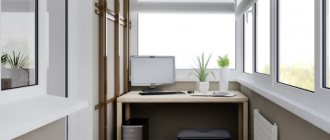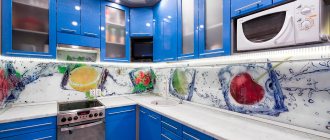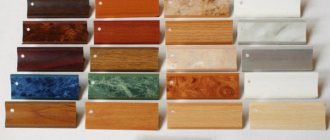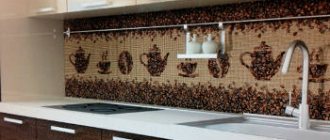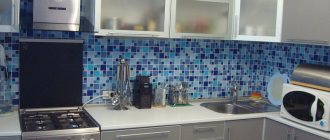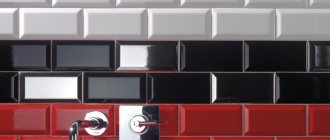A brick-look kitchen apron is a very popular design solution. The reason for this is that block masonry itself is found in many interior styles. In this case, different materials, textures and sizes of bricks can be used. However, natural brick is a rather bulky material, so its imitation is more often used.
Various types of tiles and decorative facing bricks are used to lay out the apron. The modern market offers a wide range of such finishing materials. You can install an apron in the kitchen yourself, which will help significantly save your budget.
Brick kitchen apron: features
Using a variety of tactics, remodelers can style a kitchen backsplash in a variety of ways. You can lay it chaotically, imitate masonry, or create cladding in rows. Various materials are used to finish the apron. They help make the wall as natural and beautiful as possible. But before choosing an option, you need to consider a few recommendations:
- Strength. The surface of the material must withstand mechanical stress (accidentally hit with a knife, spoon, or pan lid). Typically, brickwork has a non-uniform texture, so even accidental chips cannot be avoided.
- Withstands high temperatures. The kitchen is very hot when cooking, especially near the gas stove. It is important that the material does not deform from heating and does not melt from splashes of hot fat.
- Moisture resistance. The surface of the apron should not absorb liquid. As a result, it will begin to swell, and accordingly the work area will lose its aesthetic appearance. And, if the brick is set on mortar, it will begin to peel off over time.
- Basic care. The coating should be easy to clean and not deteriorate from exposure to chemical cleaning compounds. The ideal solution is a material that is varnished.
Tile in the form of brickwork with separate decoration in the apron area Source design-homes.ru
Textured wallpaper with imitation brickwork for a kitchen backsplash Source homedesigning-ideas.blogspot.com
Kitchen apron made of real brickwork Source dizainexpert.ru
An apron made of PVC panels with imitation brickwork and an interesting structure Source womanadvice.ru
Types of material
It is quite natural that the workspace behind the kitchen furniture can be made of brick. Moreover, in some cases there is no need for its artificial design if it is possible to leave part of the wall in its original form.
Brick stone is considered a strong and durable material, has a unique texture and color options. It is necessary to take into account that the material has a porous structure and is capable of absorbing not only moisture, but also odors. In addition, it is quite difficult to remove contaminants from such a surface.
As a rule, a rough wall is finished with practical building materials.
Ceramic tile
It is the most common option, vaguely reminiscent of brick stone. These tiled bricks for the kitchen look quite neat, the color palette is wide, there are matte and glossy tones. The tile material can break or crack, but if you handle it carefully, it will last for decades, maintaining its appearance. In addition, such a surface is easy to wash and clean.
Porcelain tiles
A brick-look kitchen apron made of this material has properties similar to a ceramic surface. Among the few differences, an increased strength index and a manufacturing method are noted, during which not only the top layer, but also the entire tile is painted. Elements can have a glaze coating or retain their natural appearance, resembling as much as possible ordinary brick stone.
Clinkers
Such bricks are superior to tiles in many respects, especially in strength and wear resistance. This material is produced in a special way, which allows it to look natural. The surface can be embossed or have a smooth coating. The color palette is quite extensive.
Caring for clinker is easy if the material has a smooth surface. In addition to the high price, such tiles require the involvement of an experienced specialist during installation.
Polymer cement
The material is new to the construction market; its properties resemble clinker. It has low porosity and is not susceptible to moisture. Its light weight simplifies the installation process.
Gypsum tiles
The most cost-effective option is to make a brick kitchen apron with your own hands. Gypsum tile material quite convincingly recreates brick stone, but has a significant drawback - it absorbs water and is quickly subject to destructive processes. To protect the surface, the product is treated with a silicone compound, after which a special varnish is applied on top.
Wallpaper
This finishing material is considered the most accessible and inexpensive. True, the decorative surface has to be protected with a glass or polycarbonate screen.
PVC panels
One of the inexpensive types of coatings that imitates brickwork. What is meant here is not individual tiles, but relief panels that look like a brick wall. Fastening such a panel is much faster than installing tiles, and replacing it is quite simple. The plastic surface is easy to clean using gentle chemicals, but has low strength and resistance to heat.
Glass panel
A modern solution in which the image of brickwork is applied to the glass surface from the inside. The advantages are considered to be excellent and very realistic color reproduction and mirror shine. The surface is smooth and easy to clean. In terms of strength, glass that has undergone a tempering procedure competes with tile material. Installation work causes certain difficulties associated with the weight and size of the product and complex fastening.
MDF panels
They are used quite often to imitate brickwork. The surface of the panels is finished with a special protective film, painted to resemble brickwork. This film partially protects the panels from getting wet, but can change its original shade or be deformed due to strong heating. Many people choose this option as it is cheaper than a glass panel. But its installation is possible on your own.
Choice of color and masonry
To imitate a brick wall in the kitchen in the countertop area, you can use several methods. It is also important to choose the right shade that will harmonize with the interior. There are the following masonry options:
- Classical. It consists of installing clinker tiles or “hogs” strictly on top of each other. It turns out that each individual part is laid out in rows.
- With offset. This method best matches the imitation of a brick wall. When laying each new row, the first brick or tile is shifted by half.
- Parquet or herringbone. This is an original method that is suitable for kitchens with a high ceiling. Tiles or small bricks are laid at an angle to each other.
- Vertical. This option involves gluing the tiles vertically and parallel to each other without displacement.
Using plastic panels to cover the apron in the kitchen Source kuhnier.ru
Brick tiles in a backsplash in the kitchen Source prointerno.io
Pros and cons of the solution
Imitation of natural brick or a natural base is an original way to decorate a room. Most often, this decor is used when decorating a work apron. It can also be a free-standing small wall - a partition. These approaches can also be combined. This type of finish will never become outdated. The technology has a number of advantages and disadvantages. Positive qualities include:
- wide range of shades and textures;
- originality of the idea;
- the possibility of timely replacement of some parts;
- ease of maintenance and operation;
- durability and strength (depending on the chosen material).
As for the negative qualities of a “brick” apron, visible dirt quickly appears due to the heterogeneous structure. They will be especially noticeable in the seams between tiles or bricks.
Two options for brickwork in the kitchen in the apron area in white Source design-homes.ru
Peculiarities
Brick has long been not just a building material, but also an option for interior decoration. Such is human nature: we used to hide a brick wall under plasterboard, primer and wallpaper, and now, in this entire multi-layered space, we are trying to recreate a canvas that looks as much like a brick as possible.
What are the benefits of this design?
Firstly , a brick wall looks luxurious and rich.
Secondly , it will fit into any style: Loft, Provence, Country and others.
The “brick” texture of the wall does not require frequent careful maintenance, because it masks light dirt and abrasions.
Finally, the “brick” wall serves faithfully for many years . Even if you decide to change the wallpaper, curtains, furniture, the white brick wall will remain relevant and modern.
There are several options for recreating a white brick wall.
The first and most logical is natural brick. Obvious advantages of natural brick:
- Durability.
- On a real brick there are almost no drops of grease or traces of other “misunderstandings” visible.
- Easy to care for.
- Naturalness. You are not just creating an imitation brick, but using the “original”.
- Moisture resistance.
But there are also some disadvantages:
- Quite labor-intensive and time-consuming installation. It's not easy to paste wallpaper!
- Real brick “eats” precious centimeters of space.
- Requires special impregnation or a glass panel on top.
What style would a brick apron go with?
Most interior styles favor having a brick wall in the kitchen. Most of all, such an apron will correspond to the following design trends.
Loft
This solution is based on the use of tools and materials of ancient or industrial origin. It is the brickwork that will be the main attribute. In the loft you cannot use materials such as MDF, PVC panels, or hog tiles.
Apron with brickwork in rows in a Provence interior Source 5domov.ru
Provence
Here, on the contrary, it is better to finish it with tiles or use snow-white bricks to decorate the wall in the kitchen work area. It is also acceptable to use artificially aged materials: clinker tiles, decorative bricks. As for the shades for the seams, the most natural ones are suitable here: straw, sand, milky, cream.
English-style kitchen with imitation brickwork in the area Source 5domov.ru
English style
If you organize a brick wall in a kitchen with such an interior, it is best to use bright shades: red, fiery orange, brown. They should be a contrast against the background of furniture and other details.
Art Nouveau style in the kitchen with imitation brickwork and tiles in the work area Source dizainvfoto.ru
What to consider when laying bricks
In order for the tiles to stick firmly to the wall, the surface must be prepared before laying. The walls are degreased and cleaned of dust and dirt. The tile will lie well on a flat surface, so the walls are leveled. Before starting work, the base must be primed.
Brick in the kitchen interior looks advantageous, and it is not difficult to lay such material. However, before purchasing, you need to consider the material consumption. Plain tiles are bought with a small margin, because they break and are cut. The supply of multi-colored tiles or a batch with a pattern must be at least 10%.
Before starting work, you need to select the workpieces and make a layout to determine the location and quantity of the required products. In those places where cabinets hang, tiles are not placed. A line is marked on the wall where the installation will begin. First, the material is laid out on a flat surface of the working area. Broken pieces and corner parts are used last. Holes for sockets are cut with a hammer drill or grinder.
Design of a kitchen apron made of white bricks in photo
Decorating a wall in the work area with imitation brickwork Source stonehouse54.ru
Design of an apron with brickwork in the apron area in the kitchen Source dizajnintererov.com
Decorating an apron in the kitchen with white tiles Source dizajnintererov.com
Facing the apron with bricks in ash and white shades Source design-homes.ru
Textured tiles laid like bricks in the work area Source dekoriko.ru
Design of a working area with brickwork with dark seams in the kitchen Source behance.net
Using tiles with a 3D effect to decorate a kitchen backsplash Source behance.net
